One Hundred Years a Hero
Written by Jax Monroe
Illustrated by Mary Hammond
For the series A BOOK by ME - True Stories Written by Kids for Kids
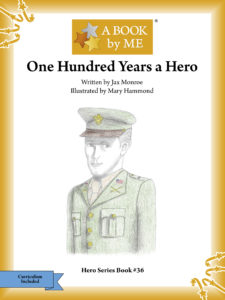 WWII Veteran Charlie Kirkpatrick lived a couple cornfields away from me when we met. It was an honor to tell his story through A BOOK by ME. When I brought a widow of a Pearl Harbor survivor to the interview and when 100-year-old Charlie learned about his service, he jumped up and ran down the basement stairs to grab something he wanted to show her. I was in awe that a man his age had so much energy. Months later when his book was published, I put something on social media about his story and his love for the ship, Queen Mary. That same day, I received an email from the Executive Director of the Queen Mary Foundation. She wanted Charlie’s contact information. A great reminder that you absolutely never know who is going to read those posts you put out there. Due to the pandemic, nothing came of this relationship but it was exciting nonetheless.
WWII Veteran Charlie Kirkpatrick lived a couple cornfields away from me when we met. It was an honor to tell his story through A BOOK by ME. When I brought a widow of a Pearl Harbor survivor to the interview and when 100-year-old Charlie learned about his service, he jumped up and ran down the basement stairs to grab something he wanted to show her. I was in awe that a man his age had so much energy. Months later when his book was published, I put something on social media about his story and his love for the ship, Queen Mary. That same day, I received an email from the Executive Director of the Queen Mary Foundation. She wanted Charlie’s contact information. A great reminder that you absolutely never know who is going to read those posts you put out there. Due to the pandemic, nothing came of this relationship but it was exciting nonetheless.
 Charlie, like most of the veterans I’ve met on my journey, didn’t consider himself a hero. In my mind, his young author’s mind, and in his loving family’s minds, he’s definitely a hero. As kids head back to school this fall, I’m grant writing. It’s my sincere hope that many of them will soon have Charlie’s book in their hands so they can meet an unsung hero of WWII. Charlie and other subjects live in rural areas and the kids who preserve their stories go to rural schools. Our new logo will be found on some new book releases in the very near future to honor communities like Charlie’s. Some rural schools don’t get as many opportunities as our bigger schools do. I’m proud to offer these educational opportunities to students in small and large schools. – Deb Bowen, Creator A BOOK by ME
Charlie, like most of the veterans I’ve met on my journey, didn’t consider himself a hero. In my mind, his young author’s mind, and in his loving family’s minds, he’s definitely a hero. As kids head back to school this fall, I’m grant writing. It’s my sincere hope that many of them will soon have Charlie’s book in their hands so they can meet an unsung hero of WWII. Charlie and other subjects live in rural areas and the kids who preserve their stories go to rural schools. Our new logo will be found on some new book releases in the very near future to honor communities like Charlie’s. Some rural schools don’t get as many opportunities as our bigger schools do. I’m proud to offer these educational opportunities to students in small and large schools. – Deb Bowen, Creator A BOOK by ME
 “My mom learned about a 100-year-old WWII veteran in our hometown from Lois Breachbiel, a daughter in the Chief Shaubena Chapter of Daughters of American Revolution (DAR). They wanted someone young to write and illustrate his story. So, we met at Charlie’s kitchen table in October of 2019 and he told us about sailing to Europe on the Queen Mary with the first shipment of women in the Women’s Army Corp (WAC).” — Author Jax Monroe
“My mom learned about a 100-year-old WWII veteran in our hometown from Lois Breachbiel, a daughter in the Chief Shaubena Chapter of Daughters of American Revolution (DAR). They wanted someone young to write and illustrate his story. So, we met at Charlie’s kitchen table in October of 2019 and he told us about sailing to Europe on the Queen Mary with the first shipment of women in the Women’s Army Corp (WAC).” — Author Jax Monroe
“One Hundred Years a Hero” available on Amazon >>
Charles Kirkpatrick
U.S. Army, 15th Calvary, Mechanized
 Charles (Charlie) Kirkpatrick celebrated his 100th birthday on September 22, 2019. He was born in 1919 in Warren County, Illinois. His parents were farmers with seven children, four boys and three girls. Young Charlie remembers playing baseball for fun with his siblings and his friends. He hunted groundhogs as well. The holes they dug were openings to underground tunnels, and his family’s work horses, used for farming before tractors, could break a leg by stepping in their holes. Charlie was paid ten cents a head for each groundhog he shot.
Charles (Charlie) Kirkpatrick celebrated his 100th birthday on September 22, 2019. He was born in 1919 in Warren County, Illinois. His parents were farmers with seven children, four boys and three girls. Young Charlie remembers playing baseball for fun with his siblings and his friends. He hunted groundhogs as well. The holes they dug were openings to underground tunnels, and his family’s work horses, used for farming before tractors, could break a leg by stepping in their holes. Charlie was paid ten cents a head for each groundhog he shot.
The Great Depression began when Charlie was a teenager, but it didn’t affect him or his family like it did other families who lived in the city. They had three huge gardens, 15 milk cows, some pigs and lots of fruit trees. There was no food shortage and no shortage of work either. Charlie and his siblings would milk their cows sitting on three legged stools, squirting the milk into a can. He remembers sugar rations during this time, but his mom was a wonderful cook and could make anything taste good. The U.S. Government started rationing sugar, butter and meat, which were in short supply. Charlie remembers his mother keeping a ledger of every penny they spent. “If she bought us a sucker, it was in her ledger. One penny!”
Charlie graduated from Roseville High School in 1939 with a dream of becoming an industrial arts teacher. He began his education at Illinois State Teachers College (now Western Illinois University), but by the end of his junior year, he signed up for the first draft from Monmouth, Illinois. His plan was to serve only one year as the military promised, and then he would return to WIU for his senior year. He traveled to Chicago for testing and headed to Fort Riley, Kansas for basic training. His train to Kansas went right through Warren County, and he waved when he passed by. At Fort Riley he was taught to fire guns: rifles, pistols and infantry weapons.
Then, the Japanese attacked Pearl Harbor and the U.S. declared war. Charlie was at a movie theater and came out to hear people talking about the attack on Pearl Harbor. The new rule became, “If you are in the Army, you are in the Army to stay.” However, the first attack Charlie saw was from his own appendix. The Army doctor suggested they operate, and to his surprise, they used his surgery to teach a new surgeon how to make an incision on a real patient. While he got his strength back after surgery, he inquired about Officers Candidate School (OSC). He applied and was selected.
Charlie’s wedding was held at Fort Riley when his hometown girl, Norma Twomey, came to town along with both sets of parents, Charlie’s sister who was maid of honor, and Norma’s brother who was the best man. After graduation from OCS, he was a 2nd Lieutenant and was sent to Fort Gordon, Georgia. Many soldiers there struggled to read maps. People didn’t travel far in their Model T cars back then, so maps weren’t used as much. But, map skills were needed before going off to war, so Charlie helped to teach them.
Charlie served from 1941 to 1946. He was assigned to the 15th Calvary Group, Mechanized. In WWI the troops used horses, but this WWII generation drove jeeps and tanks. In 1944, he sailed for England on the Queen Mary, which was the best troop transport the Allies had. This particular crossing carried the first shipment of women who were part of the Women Army Corps (WAC). These brave women served in noncombat positions. their motto was, “Free up a man to fight.”
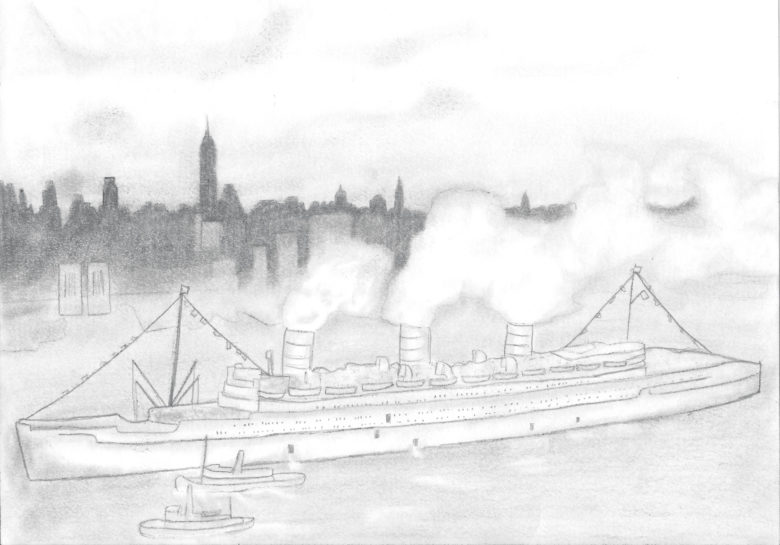
Charlie was a tank commander, the guy, he said, “with his head sticking out of the top of the tanks.” Upon arrival, the troops learned about decoys: fake tanks, trucks, and jeeps made out of plywood; also, inflatable tanks. These were all designed to trick the enemy into believing the other side’s strength was much larger than it was. Germany often sent reconnaissance planes over Great Britain to gather information on troop movements for strategic planning, so the fake equipment was intended to fool them.
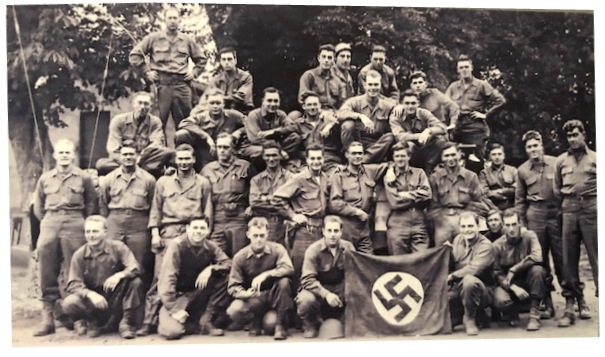
Victory photo, captured the flag
Charlie’s troop landed at Omaha Beach in the middle of the night. Charlie and his men had to carry their barracks bags or duffe bags with all of their possessions, and climb down a cargo net in order to get off the ship and into smaller boats. They landed after midnight when everything was dark because of the blackout. At night, all windows and doors were covered with suitable material to prevent any glimmer of light that might aid enemy aircraft. After getting ashore, the soldiers were put in the back of trucks, and a canvas flap was pulled down behind them. Charlie’s unit was ordered to patrol a section of the Loire River. The German forces were divided, and the U.S. troops were attempting to keep the Germans in southern France so they couldn’t get back in the fight. It wasn’t too hard, because most of the German soldiers didn’t want to go back. Some were in civilian clothes, but the Americans were aware they were Germans.
Afterward, Charlie’s squadron was ordered to go to Belgium where the Battle of the Bulge had just been fought. Their assignment was to guard General George Patton; they were his first line of defense. The war ended and, finally, it was time to go home. Charlie still remembers their arrival into New York early in the morning. Everyone was looking for the Statue of Liberty. Lady Liberty was looking particularly beautiful to the troops that day. All were thankful to be home.
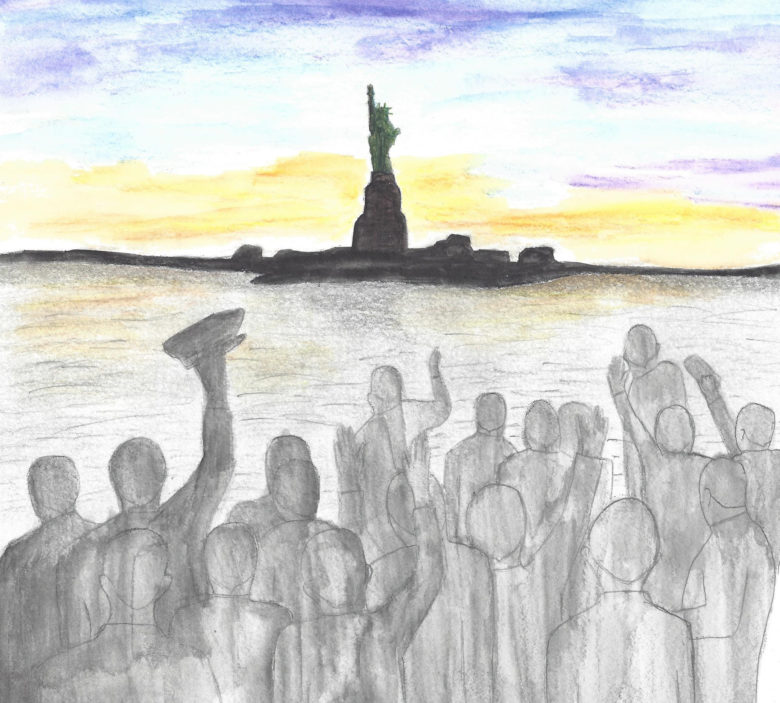
Charlie flew to Chicago for discharge, and then he took the train to Galesburg, where his wife met him. Back at home, he Finally finished his last year of college, and he and Norma raised eight children. He worked many years as an industrial arts teacher at Mt. Carrol High School. He also worked for the Twomey Company, building large grain bins and houses; at age 100 he still lives in one of the houses he built.
After Charlie retired, he and his wife, Norma, and two adult daughters, Kay and Linda, visited Europe; they went to the American cemetery in Normandy. It was a very emotional experience and one that provided some closure for a soldier whose job was well done.
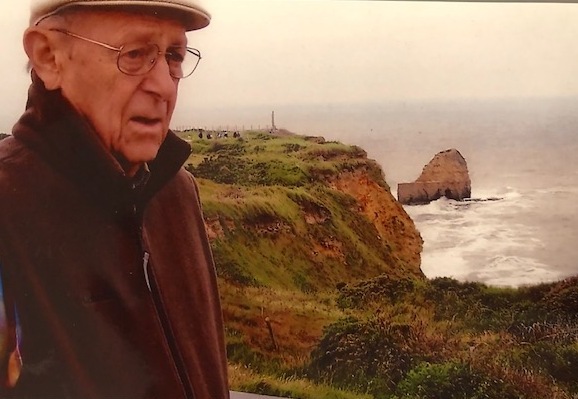
Revisiting Normandy

Illustrator Mary Hammond

Author and Illustrator with Charlie
A BOOK by ME, a book series developed by Deb Bowen, empowers students to preserve history by telling the story of unsung heroes in our communities. For the young participants, it’s a guided cross-curricular project that gathers stories of people who do amazing things but have received little or no recognition. Students learn how to publish a picture book that is a primary source document with photographs and a biography.
Since 2003, Deb Bowen has been arranging meetings between students and individuals from the WWII generation. This intergenerational storytelling results in unique storybooks written and illustrated by kids for kids in the A BOOK by ME series. More about Deb Bowen >




